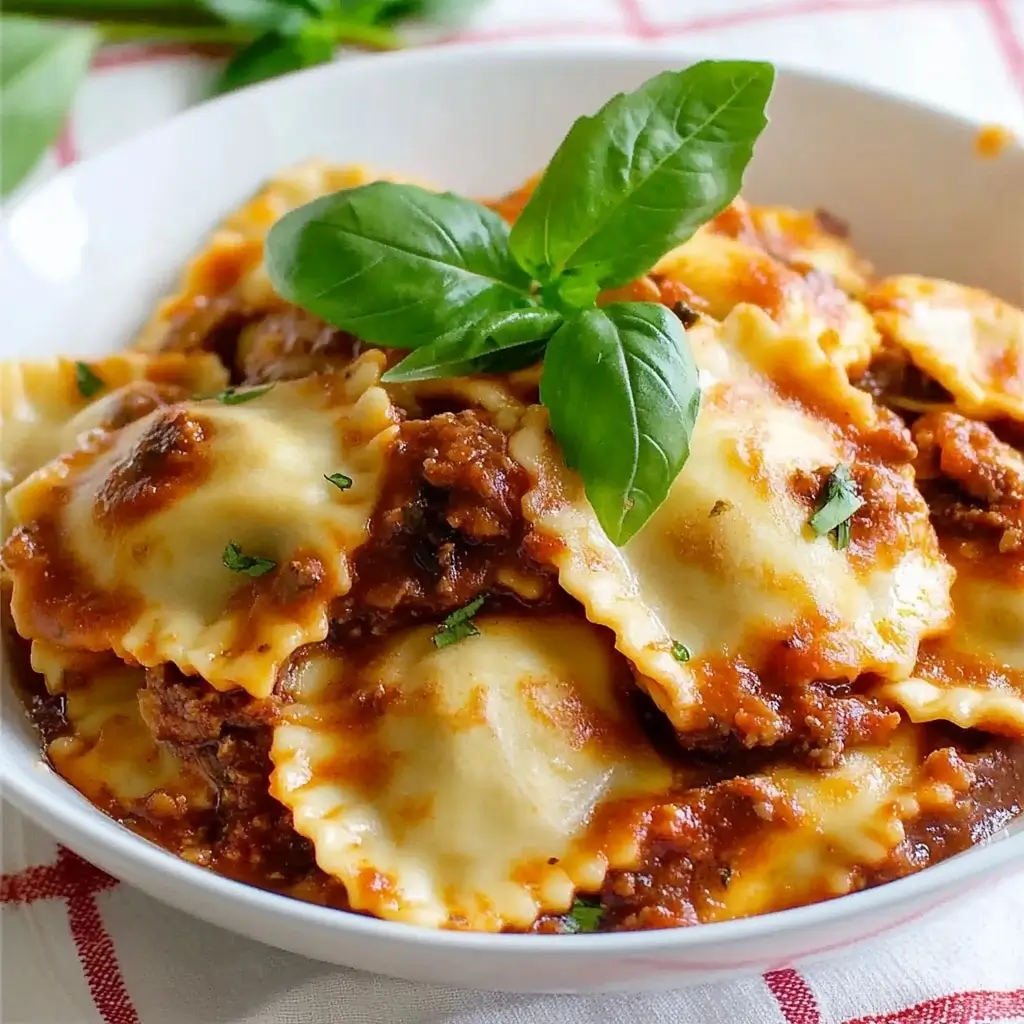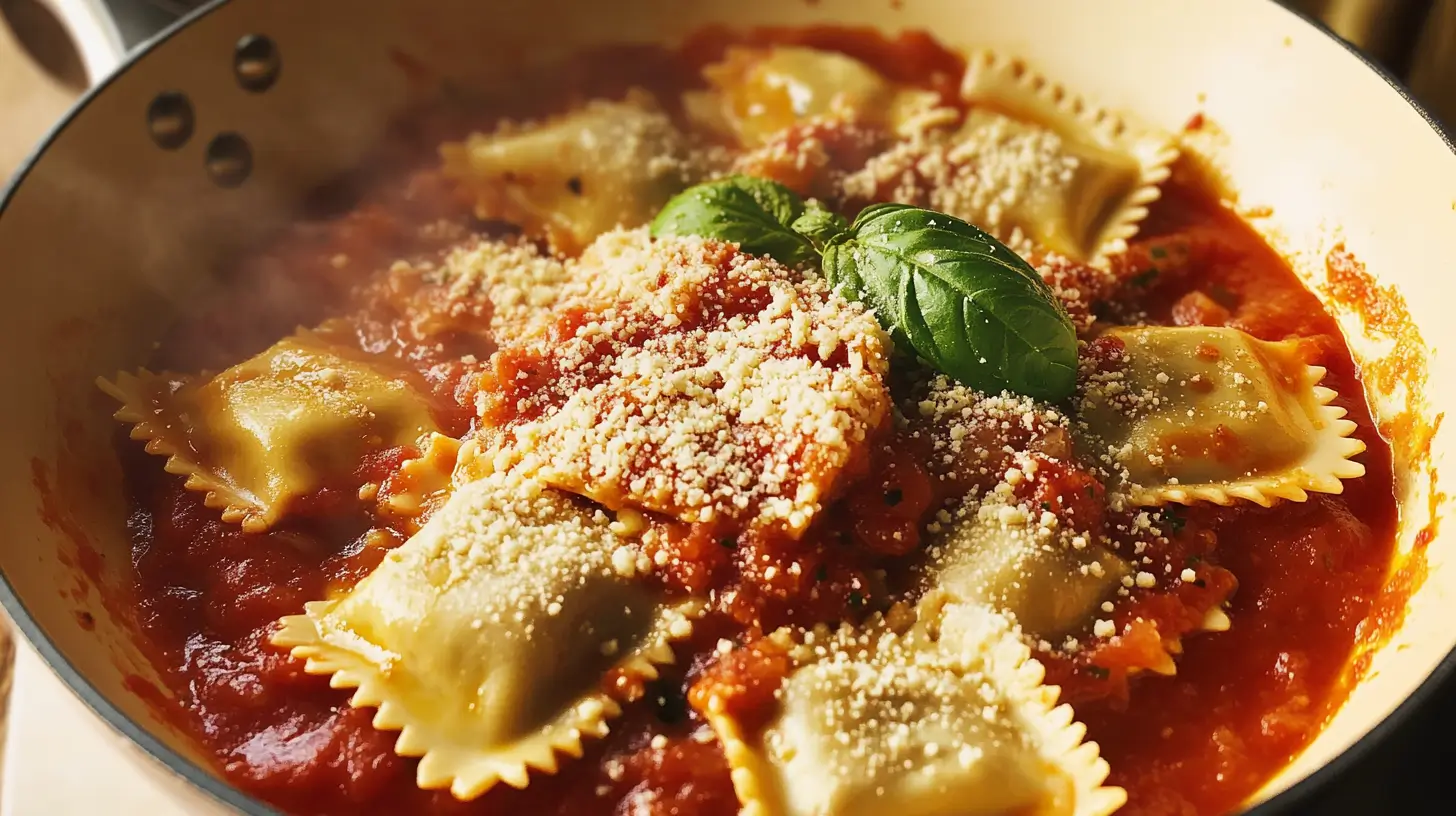If you’re wondering whether you can cook frozen ravioli directly in sauce, the short answer is: yes! This method is not only convenient but also enhances the flavor of the dish. Instead of boiling water separately, the ravioli absorb the richness of the sauce as they cook, creating a more cohesive meal. Whether you’re preparing a classic marinara or a creamy beef pasta, this technique saves time and minimizes cleanup. But how do you do it correctly to avoid mushy or undercooked pasta? Let’s break it down.
Table of contents
- Understanding Frozen Ravioli
- Traditional Ravioli Cooking Methods
- Cooking Ravioli in Sauce: An Overview
- Sauce Selection for Cooking Frozen Ravioli
- Step-by-Step Guide to Cooking Frozen Ravioli in Sauce
- Adjusting Cooking Times
- Enhancing Flavor While Cooking in Sauce
- Addressing Common Concerns
- Frequently Asked Questions
- Conclusion
Understanding Frozen Ravioli
What is Frozen Ravioli?
Frozen ravioli is a convenient and versatile food item loved by many for its ability to deliver delicious flavors with minimal preparation. These pre-filled pasta pockets come in a variety of fillings, from classic cheese and spinach to gourmet options like lobster or truffle. The freezing process preserves their texture and taste, ensuring they’re ready to be transformed into a quick and satisfying meal.
The beauty of frozen ravioli lies in its simplicity. It’s fully pre-cooked before freezing, meaning all you need to do is reheat it until tender. While boiling is the traditional preparation method, many home cooks are turning to alternative methods, such as cooking ravioli directly in sauce, for added convenience and flavor.
Why People Prefer Frozen Over Fresh Ravioli
Fresh ravioli may be the gold standard for flavor and texture, but it’s not always practical. Frozen ravioli offers several advantages that make it a favorite among busy families and solo cooks alike:
- Long Shelf Life: Unlike fresh pasta, frozen ravioli can be stored for months without losing quality. This makes it a reliable pantry staple.
- Quick Preparation: With no need to mix, roll, or fill dough, frozen ravioli skips the time-consuming steps of homemade pasta.
- Variety of Options: From vegetarian-friendly to meat-filled varieties, frozen ravioli caters to a wide range of tastes.
- Cost-Effective: Frozen ravioli is often more affordable than fresh, especially when bought in bulk or on sale.
Understanding these benefits is key to appreciating why frozen ravioli is a great candidate for direct cooking in sauce.
Traditional Ravioli Cooking Methods
Boiling Method Overview
The classic method for cooking ravioli involves boiling a pot of salted water and gently simmering the pasta until it floats to the surface. While this technique is reliable, it comes with a few challenges. Overcooking can lead to waterlogged ravioli, while undercooking may result in a tough, chewy texture. Moreover, if not handled carefully, ravioli can burst, spilling the filling into the water.
Common Issues When Boiling Ravioli
- Tearing or Breaking: Frozen ravioli can sometimes stick together or tear when submerged in boiling water.
- Inconsistent Cooking: Uneven heat can leave some ravioli perfectly cooked while others remain underdone.
- Draining Hassles: Straining ravioli adds an extra step, and if not done gently, it can damage the pasta.
These challenges lead many cooks to explore alternative methods like cooking ravioli directly in sauce. This approach eliminates the risks of tearing and ensures the ravioli absorbs the sauce’s flavor throughout the cooking process.
Cooking Ravioli in Sauce: An Overview
How Sauce Cooking Differs
Cooking frozen ravioli directly in sauce is a game-changer for anyone seeking simplicity in the kitchen. Unlike the boiling method, where pasta is cooked separately and combined with sauce later, this technique merges the two steps into one. The ravioli cooks gently in the sauce, absorbing its flavors while releasing starch, which thickens the sauce slightly. This creates a harmonious dish with every bite infused with richness.
Key differences include:
- Single-Pot Cooking: Everything happens in one pot or pan, reducing cleanup time and effort.
- Enhanced Flavor: Ravioli soaks in the sauce, creating a more cohesive flavor profile.
- More Controlled Cooking: Gentle simmering prevents overcooking or tearing.
Benefits of Cooking Ravioli in Sauce
There are several reasons why this method is becoming increasingly popular:
- Time-Saving: No need to boil water, drain pasta, or clean multiple pans.
- Enhanced Texture: The ravioli retains its shape better and doesn’t risk becoming waterlogged.
- Convenience: Perfect for busy nights or when you want a low-effort meal with high impact.
- Customizable: You can adjust the sauce’s flavor, thickness, and ingredients while cooking.
Whether you’re a beginner cook or an experienced foodie, this approach offers a stress-free way to prepare a delicious, satisfying meal.
Sauce Selection for Cooking Frozen Ravioli
Best Types of Sauce for This Method
The type of sauce you choose can make or break this method. Thicker, heartier sauces work best, as they provide a stable cooking environment for the ravioli. Here are some top choices:
- Marinara Sauce: A classic tomato-based sauce that pairs well with cheese or meat ravioli.
- Creamy Alfredo Sauce: A rich, velvety option ideal for spinach or mushroom ravioli.
- Pesto Sauce: While thinner, pesto works well when combined with a splash of cream to coat the ravioli evenly.
Sauces to Avoid
Certain sauces may not work as well for cooking frozen ravioli:
- Thin, Watery Sauces: These don’t provide enough coverage or flavor and may cause uneven cooking.
- Oil-Based Sauces: While flavorful, they lack the liquid content needed to cook ravioli fully.
- Sauces with Delicate Ingredients: Fresh herbs or seafood-based sauces can overcook during the process.
Choosing the right sauce sets the stage for a successful one-pot ravioli dish.
Step-by-Step Guide to Cooking Frozen Ravioli in Sauce
Ingredients and Equipment Needed
Before you start, gather the following essentials to ensure a smooth cooking process:
Ingredients
- 1 package of frozen ravioli (cheese, meat, or your preferred filling)
- 2–3 cups of your chosen sauce (marinara, Alfredo, or another thick sauce)
- ½ cup of water or broth (to prevent the sauce from drying out during cooking)
- Optional: grated Parmesan cheese, fresh basil, or parsley for garnish
Equipment
- A large, deep skillet or sauté pan with a lid
- A wooden spoon or spatula for stirring
- Measuring cups for accuracy
Cooking Steps in Detail
- Prepare the Sauce
Pour your sauce into a large skillet or pan and place it over medium heat. If the sauce is particularly thick, add about ½ cup of water or broth to thin it slightly. Stir gently to combine. - Add the Frozen Ravioli
Place the frozen ravioli directly into the sauce. Ensure they are evenly spaced and fully submerged for consistent cooking. Avoid overcrowding the pan, as this can lead to uneven heating. - Simmer and Cover
Once the sauce begins to bubble gently, lower the heat to a simmer and cover the pan with a lid. This creates a steam effect, helping to cook the ravioli evenly without scorching the sauce. - Stir Occasionally
Every 3–5 minutes, remove the lid and give the ravioli a gentle stir to prevent sticking. Be careful not to break the ravioli, as they become delicate as they cook. - Check for Doneness
After about 10–12 minutes, check if the ravioli are tender by piercing one with a fork or tasting it. The exact cooking time may vary depending on the ravioli’s size and filling. - Adjust the Sauce
If the sauce has thickened too much, add a splash of water or broth to reach your desired consistency. Stir well to combine. - Add Finishing Touches
Sprinkle grated Parmesan cheese over the ravioli and garnish with fresh herbs like basil or parsley. - Serve and Enjoy
Plate the ravioli and sauce while hot, ensuring each portion is generously coated. Pair with garlic bread or a simple salad for a complete meal.
Tips for Avoiding Sticking or Burning
- Use a Non-Stick Pan: A non-stick skillet helps prevent ravioli from sticking to the bottom during cooking.
- Stir Gently: Frequent, gentle stirring ensures even cooking and avoids scorching.
- Monitor Heat Levels: Keep the sauce at a low simmer rather than a rolling boil to maintain control.

Adjusting Cooking Times
How Frozen Ravioli Affects Cooking Time
Cooking frozen ravioli directly in sauce requires a slightly longer cooking time compared to boiling, but the process is still quick and convenient. Here’s why:
- Frozen State: Unlike fresh ravioli, frozen ones need additional time to thaw and cook through.
- Sauce Thickness: Thick sauces may slow heat transfer, requiring a bit more patience.
- Cooking Temperature: Simmering sauce cooks ravioli more gently than boiling water, which reduces the risk of overcooking but adds a few extra minutes to the process.
Generally, frozen ravioli will take about 10–12 minutes to cook in sauce. This can vary slightly depending on the ravioli’s size and filling.
Recognizing When Ravioli is Fully Cooked
To ensure perfectly cooked ravioli, look for these signs:
- Tender Texture: Gently press a piece with a fork or spoon. If it yields easily without feeling rubbery, it’s ready.
- Floating Effect: While this is more noticeable in boiling water, ravioli in sauce will feel lighter and slightly puffed when cooked.
- Taste Test: The simplest and most reliable method is tasting one to check for doneness. It should be tender with no hint of firmness in the center.
- Filling Temperature: Cut one ravioli open to ensure the filling is hot and evenly cooked.
What to Do If Ravioli is Undercooked
If you find the ravioli still firm after the initial cooking time:
- Add a few tablespoons of water or broth to the sauce and continue simmering for 2–3 minutes.
- Stir gently to ensure the ravioli heats evenly.
By adjusting the timing and keeping an eye on the ravioli’s texture, you’ll achieve a perfect consistency every time.
Enhancing Flavor While Cooking in Sauce
Adding Fresh Herbs and Spices
One of the easiest ways to elevate the flavor of ravioli cooked in sauce is by incorporating fresh herbs and spices. These simple additions can transform a basic dish into something extraordinary:
- Fresh Herbs: Add basil, parsley, or oregano during the last few minutes of cooking for a burst of freshness.
- Spices: A pinch of red pepper flakes or freshly cracked black pepper can add depth and a hint of spice.
- Garlic and Onion: Sauté minced garlic or onion in the sauce before adding the ravioli for a rich, aromatic base.
Incorporating Vegetables or Proteins
For a more complete meal, consider adding vegetables or proteins directly into the sauce. This not only boosts the dish’s nutritional value but also adds layers of flavor:
- Vegetables: Sliced mushrooms, spinach, zucchini, or cherry tomatoes pair beautifully with ravioli and cook quickly in sauce.
- Proteins: Cooked sausage, shredded chicken, or even crispy pancetta can make the dish heartier.
To add these ingredients:
- Sauté them in the pan before adding the sauce to release their flavors.
- Combine with the sauce and ravioli, allowing everything to cook together for a unified taste.
Balancing Flavors
If the sauce tastes too acidic (common in tomato-based sauces), add a teaspoon of sugar or a splash of cream to mellow it out. For creamy sauces, a squeeze of lemon juice or a sprinkle of Parmesan can brighten the flavor.
Adding a Crunchy Garnish
Before serving, sprinkle the dish with toasted breadcrumbs, pine nuts, or grated Parmesan for added texture. These small touches can elevate the presentation and taste, making the meal feel gourmet.
Addressing Common Concerns
Will the Ravioli Cook Evenly?
This is one of the most frequently asked questions about cooking ravioli directly in sauce. The good news is that with a few simple techniques, you can ensure even cooking:
- Submerge the Ravioli: Make sure each piece is fully covered in sauce so it cooks uniformly.
- Stir Occasionally: Gently stir every 3–5 minutes to prevent sticking and ensure even heat distribution.
- Use a Lid: Covering the pan traps steam, which helps cook the ravioli evenly from all sides.
By following these tips, you can avoid undercooked centers or uneven textures.
Can This Method Lead to Soggy Pasta?
The worry about soggy ravioli often comes from overcooking or adding too much liquid to the sauce. To avoid this:
- Monitor the Cooking Time: Check for doneness after 10 minutes to avoid overcooking.
- Use the Right Amount of Liquid: Add only ½ cup of water or broth at the start. If the sauce becomes too thick, add liquid incrementally.
When done correctly, the ravioli will remain tender but firm, with a perfectly cooked filling.
What if the Sauce Becomes Too Thick or Too Thin?
Cooking ravioli in sauce can sometimes alter its consistency:
- If Too Thick: Add a few tablespoons of water, broth, or milk to loosen the sauce. Stir well to integrate the liquid without diluting the flavor.
- If Too Thin: Let the sauce simmer uncovered for a few minutes to evaporate excess liquid, stirring occasionally to prevent burning.
Does This Method Work for All Types of Ravioli?
While most frozen ravioli varieties cook well in sauce, there are a few considerations:
- Cheese Ravioli: Cooks quickly and pairs well with most sauces.
- Meat Ravioli: May require slightly more time due to the dense filling.
- Specialty Ravioli: Delicate fillings like seafood might benefit from gentler heat to avoid overcooking.
Can I Burn the Ravioli or Sauce?
Yes, if the heat is too high or you forget to stir, there’s a chance of burning. To prevent this:
- Keep the heat at a low simmer.
- Stir gently and frequently to ensure nothing sticks to the bottom of the pan.
By addressing these concerns, you can confidently use this method without any hiccups.
Frequently Asked Questions
Can I Use Fresh Ravioli with This Method?
Absolutely! Fresh ravioli can be cooked directly in sauce, but it requires less time compared to frozen ravioli. Fresh pasta cooks in about 3–5 minutes, so monitor it closely to avoid overcooking. Use a thicker sauce to prevent it from becoming too watery during the cooking process.
What’s the Best Ravioli Filling for Sauce Cooking?
Cheese ravioli is a classic choice as it pairs well with a variety of sauces, from marinara to Alfredo. However, meat-filled ravioli works beautifully with hearty tomato-based sauces or creamy options. Specialty ravioli, such as mushroom or spinach, shines in light cream or butter-based sauces to highlight the filling’s delicate flavors.
Does Cooking in Sauce Affect Ravioli Texture?
Yes, but in a positive way! Cooking ravioli in sauce ensures the pasta stays tender without becoming waterlogged, as it might in boiling water. Additionally, the ravioli absorbs some of the sauce’s flavors, creating a more cohesive dish.
What to Do if the Sauce Becomes Too Thick?
If the sauce thickens too much during cooking:
- Add a small amount of water, broth, or milk to loosen it.
- Stir well to incorporate the liquid evenly.
- Simmer for another minute to ensure a balanced consistency.
Can I Use a Slow Cooker for This Method?
Yes, cooking frozen ravioli in a slow cooker is a convenient alternative. Layer the sauce and ravioli in the cooker, ensuring the ravioli are fully submerged. Cook on low for 3–4 hours or on high for 1.5–2 hours, stirring occasionally. Keep in mind that delicate ravioli fillings may require less time.
How to Store Leftovers of Sauce-Cooked Ravioli?
Leftovers can be stored in an airtight container in the refrigerator for up to 3 days. To reheat:
- Place the ravioli and sauce in a skillet with a splash of water or broth to loosen the sauce. Heat gently over low-medium heat, stirring occasionally.
- Alternatively, reheat in the microwave in 30-second increments, stirring between intervals to ensure even warming.
Conclusion
Cooking frozen ravioli in sauce is a game-changer for busy home cooks. It simplifies the process and infuses the pasta with extra flavor. Whether you’re making a simple weeknight meal or a million dollar ravioli casserole, this method ensures a delicious, comforting dish with minimal effort. Give it a try, and you may never go back to the traditional boiling method!

